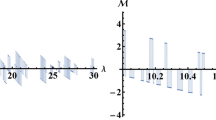Abstract
Explicit time integration is a popular method to simulate the dynamical behaviour of a system. Unfortunately, explicit time integration is only conditionally stable: the time step must be chosen not larger than the so-called “critical time step”, otherwise the numerical solution may become unstable. To reduce the CPU time needed to carry out simulations, it is desirable to explore methods that increase the critical time step, which is the main objective of our paper. To do this, first we discuss and compare three approaches to increase the critical time step: micro-inertia formulations from continuum mechanics, inertia penalties which are used in computational mechanics, and mass scaling techniques that are mainly used in structural dynamics. As it turns out, the similarities between these methods are significant, and in fact they are identical in 1D if linear finite elements are used. This facilitates interpretation of the additional parameters in the various methods. Next, we derive, for a few simple finite element types, closed-form expressions for the critical time step with micro-structural magnification factors. Finally, we discuss computational overheads and some implementational details.
Similar content being viewed by others
References
Mindlin RD (1964) Micro-structure in linear elasticity. Arch Ration Mech Anal 16: 52–78
Vardoulakis I, Aifantis EC (1994) On the role of microstructure in the behavior of soils: effects of higher order gradients and internal inertia. Mech Mater 18: 151–158
Rubin MB, Rosenau P, Gottlieb O (1995) Continuum model of dispersion caused by an inherent material characteristic length. J Appl Phys 77: 4054–4063
Chen W, Fish J (2001) A dispersive model for wave propagation in periodic heterogeneous media based on homogenization with multiple spatial and temporal scales. ASME J Appl Mech 68: 153–161
Wang Z-P, Sun CT (2002) Modeling micro-inertia in heterogeneous materials under dynamic loading. Wave Motion 36: 473–485
Metrikine AV, Askes H (2002) One-dimensional dynamically consistent gradient elasticity models derived from a discrete microstructure. Part 1: Generic formulation. Eur J Mech A/Solids 21: 555–572
Askes H, Metrikine AV (2002) One-dimensional dynamically consistent gradient elasticity models derived from a discrete microstructure. Part 2: static and dynamic response. Eur J Mech A/Solids 21: 573–588
Andrianov IV, Awrejcewicz J, Barantsev RG (2003) Asymptotic approaches in mechanics: new parameters and procedures. Appl Mech Rev 56: 87–110
Andrianov IV, Awrejcewicz J (2005) Continuous models for 1D discrete media valid for higher frequency domain. Phys Lett A 345: 55–62
Engelbrecht J, Berezovski A, Pastrone F, Braun M (2005) Waves in microstructured materials and dispersion. Philos Mag 85: 4127–4141
Gitman IM, Askes H, Aifantis EC (2005) The representative volume size in static and dynamic micro-macro transitions. Int J Fract 135: L3–L9
Metrikine AV, Askes H (2006) An isotropic dynamically consistent gradient elasticity model derived from a 2D lattice. Philos Mag 86: 3259–3286
Askes H, Wang B, Bennett T (2008) Element size and time step selection procedures for the numerical analysis of elasticity with higher-order inertia. J Sound Vib 314: 650–656
Hetherington J, Askes H (2009) Penalty methods for time domain computational dynamics based on positive and negative inertia. Comput Struct 87: 1474–1482
Askes H, Caramés-Saddler M, Rodríguez-Ferran A (2010) Bipenalty method for time domain computational dynamics. Proc R Soc A 466: 1389–
Kim J, Kang S-J, Kang B-S (2003) A comparative study of implicit and explicit FEM for the wrinkling prediction in the hydroforming process. Int J Adv Manuf Technol 22: 547–552
van den Boogaard AH, Huétink J (2006) Simulation of aluminium sheet forming at elevated temperatures. Comput Methods Appl Mech Eng 195: 6691–6709
Wang ZW, Zeng SQ, Yang XH, Cheng C (2007) The key technology and realization of virtual ring rolling. J Mater Process Technol 182: 374–381
Nakamachi E, Huo T (1996) Dynamic-explicit elastic plastic finite-element simulation of hemispherical punch-drawing of sheet metal. Eng Comput 13: 327–338
Chung WJ, Cho JW, Belytschko T (1998) On the dynamic effects of explicit FEM in sheet metal forming analysis. Eng Comput 15: 750–776
Olovsson L, Unosson M, Simonsson K (2004) Selective mass scaling for thin walled structures modeled with tri-linear solid elements. Comput Mech 34: 134–136
Macek RW, Aubert BH (1995) A mass penalty technique to control the critical time increment in explicit dynamic finite-element analysis. Earthq Eng Struct Dyn 24: 1315–1331
Olovsson L, Simonsson K, Unosson M (2005) Selective mass scaling for explicit finite element analyses. Int J Numer Methods Eng 63: 1436–1445
Plecháč P, Rousset M (2010) Implicit mass-matrix penalization of Hamiltonian dynamics with application to exact sampling of stiff systems. Multiscale Model Simul (SIAM) 8: 498–539
Milton GW, Willis JR (2007) On modifications of Newton’s second law and linear continuum elastodynamics. Proc R Soc A 463: 855–880
Andrianov IV, Awrejcewicz J (2008) Continuous models for 2D discrete media valid for higher-frequency domain. Comput Struct 86: 140–144
Pichugin AV, Askes H, Tyas A (2008) Asymptotic equivalence of homogenisation procedures and fine-tuning of continuum theories. J Sound Vib 313: 858–874
Goldenveizer AL, Kaplunov JD, Nolde EV (1993) On Timoshenko-Reissner type theories of plates and shells. Int J Solids Struct 30: 675–694
Eringen AC (1983) On differential equations of nonlocal elasticity and solutions of screw dislocation and surface waves. J Appl Phys 54: 4703–4710
Fish J, Chen W, Nagai G (2002) Non-local dispersive model for wave propagation in heterogeneous media: multi-dimensional case. Int J Numer Meth Eng 54: 347–363
Olovsson L, Simonsson K (2006) Iterative solution technique in selective mass scaling. Commun Numer Methods Eng 22: 77–82
Author information
Authors and Affiliations
Corresponding author
Rights and permissions
About this article
Cite this article
Askes, H., Nguyen, D.C.D. & Tyas, A. Increasing the critical time step: micro-inertia, inertia penalties and mass scaling. Comput Mech 47, 657–667 (2011). https://doi.org/10.1007/s00466-010-0568-z
Received:
Accepted:
Published:
Issue Date:
DOI: https://doi.org/10.1007/s00466-010-0568-z




